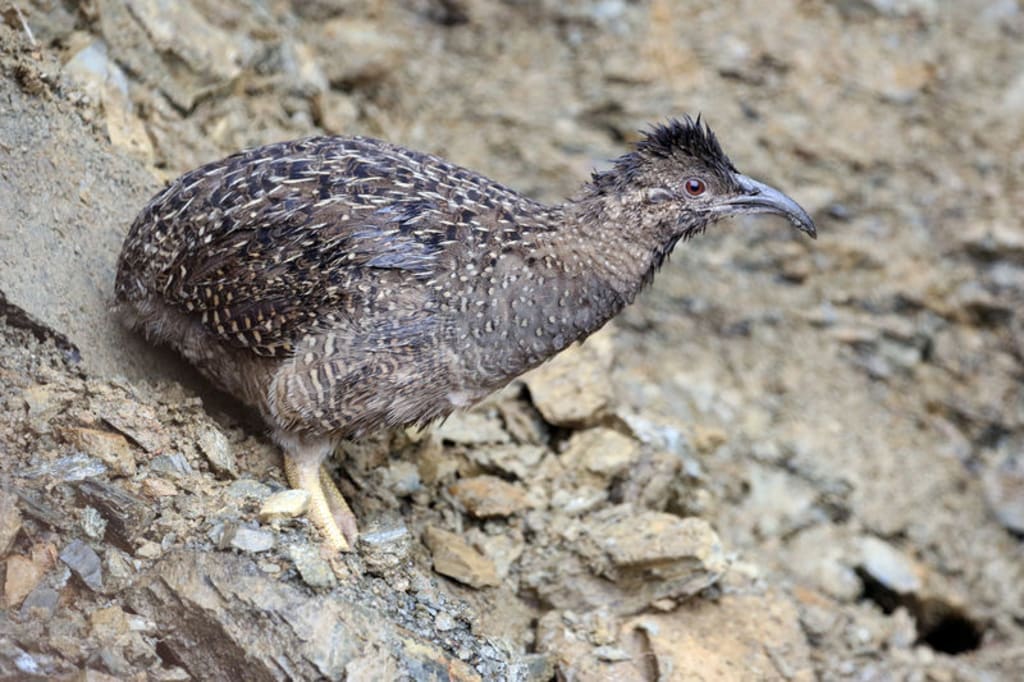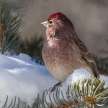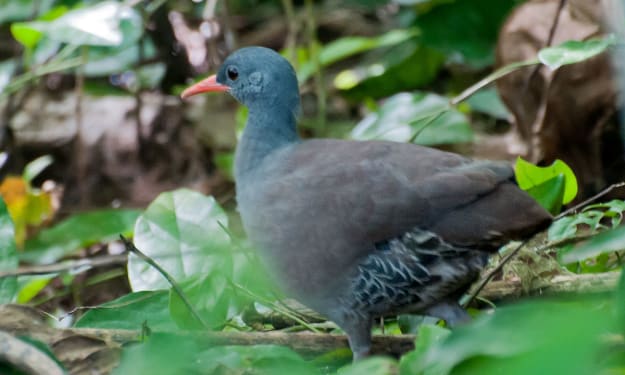
Taczanowski's tinamou (Nothoprocta taczanowskii) is a type of land bird found in Peru's eastern Andean regions Junín, Cuzco, Apurímac, Ayacucho, and Puno. This high altitude tinamou is a uncommon and possibly native inhabitant of southern Peru’s eastern slope of the Andes, and neighbouring Bolivian department of La Paz. Birdlife International officially considers it to be vulnerable, since there are usually few reported sightings, but the species can be easily recognised, if well studied, due to its unusually long, decurved bill, large size, and generally grey appearance. The Taczanowski's Tinamou is found in mosaics of cloud forest, woodland, pastures, and open rocky or grassy plains, often in wet or semi-humid mountainous areas, but also just above the treeline, between at least 2700 and 4000 m. Scrub or forest is hypothesised as a necessity for this species but it can visit farm feeding areas, e.g. tuber crops, particularly potatoes. Both Tinamou are of the family of Tinamidae and are thus ratites in the broader scheme. Tinamous, like other ratites, can float but in general they are not fast fliers. Both ratites derived from ancient flying birds, and tinamous are the closest living relative to these birds. Nothoprocta is derived from two Greek words, nothos meaning fake or falsified, and hind part or tail meaning prōktos. Scientists, however, remain unsure, suspecting that this refers tothe hidden tail beneath this species ' body feathers. Taczanowskii is also the Latin form of Władysław Taczanowski's name which was used to honour him. Taczanowski's tinamou is a black, yet finely called tinamou. The head and neck are grey on the forehead with blackish crown and light greyish hump lines on the chest. The upper parts are dusky with long, buff stripes andunobtrusive brown barring on its wing-covers, with mottling black and buffs. It has tawny, barred, blackish feathers for flight. Her breast is white, with surrounding patches of black buffy. The majority of the under sections are brown, barred dusky, with a long, blackish, pointed bill. The youths are also richer by brown colour. This tinamou has average height of 36 cm. The species gets a loud cackling cuy-cuyyy sound when flushed. It always feeds on tuber crops, and particularly on potatoes. In April and May and October they raised the eggs and the chicks. The male breeds the eggs and the chicks are born. At ground level the nest is. The Wansu mountain range, southern Apurímac, received just one specimen and was taken from the northern Kallawaya mountain range, in the Puno region, in 1871.It was reported from Marayniyuq district, Junín province, but there were presumably no surveys following the last records in 1939.The species was first recorded in Bolivia in 1999, when one male was collected in La Paz, an Apolobamba Integrated Natural Management Area, and three to four juveniles were discovered. Taczanowski's tinamou inhabits grassland and shrubland at high altitudes between 2,700 and 4,000 m above sea level. These can also be found on pastureland, and on arable land. Taczanowski's tinamou is officially listed as Vulnerable by IUCN. Their survival is threatened by the degradation of their habitats caused by human activities, such as frequent grassland burning, and the clearing, burning and grazing of livestock in high altitude copses and shrubby areas. Also by humans the bug is hunted for food. High-altitude habitats have been studied and initiatives have been suggested to restore them, such as controlling the use of burning, reintroducing old methods of high-yielding farming, limiting weeding, promoting low-impact ecotourism and related trades to produce revenue for local people, allowing local people to play a leading role in land use management and restoration. It was also planned to carry out social and political changes in order to deal with ongoing land-right disputes and promote wider use of agriculture.
About the Creator
MB
I am a bird aficionado and really enjoy spotting them them on hikes. I greatly appreciate the variety of birds cross North America and the world. They are amazing and intelligent creatures, each so unique and with a wonderful life.
Enjoyed the story? Support the Creator.
Subscribe for free to receive all their stories in your feed. You could also pledge your support or give them a one-off tip, letting them know you appreciate their work.






Comments
There are no comments for this story
Be the first to respond and start the conversation.